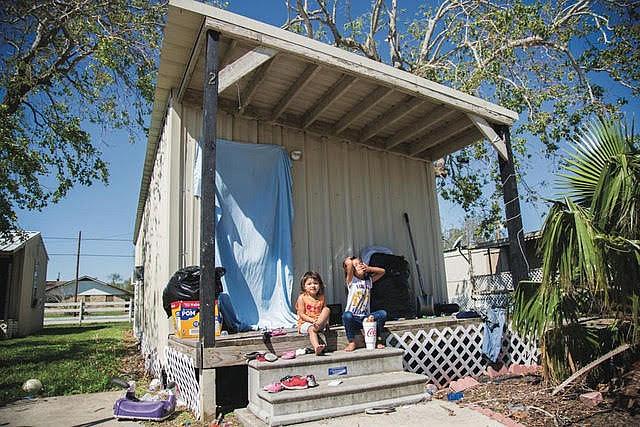Hurricane revealed gulf between Texans who can afford to rebuild — and everyone else

Laila Garcia, 4, left, and her sister, Zoey Garcia, 5, sit on the front porch of their apartment in Bloomington in Sept. 2017. The rural town of about 2,500 residents was among many communities along the Texas Gulf Coast that was devastated by Hurricane Harvey.
Over the course of a single night, four generations of Sabine Wiegand’s family were suddenly left without a home.
On Aug. 25, 2017, Hurricane Harvey ripped through communities on the Texas Gulf Coast, including the sleepy coastal town of Bayside, Texas, where Wiegand, who works as a caretaker, lived in the two-bedroom home with her 76-year-old mother, 29-year-old daughter and two grandchildren.
That same night, Monica Torres, who works as a corrections officer, and her 76-year-old mother were also left without a place to live. Nearly a year later, the two still haven’t returned home to Austwell, a town of 150 people. Their front door must be tied shut with a string because the home’s entire frame shifted.
These are just a couple of the stories that emerged in the aftermath of Hurricane Harvey, when many people who were living on fixed incomes, caring for elderly relatives or working two jobs to make ends meet lost everything.
Along with toppling mobile homes and blowing roofs off houses, Hurricane Harvey revealed a deep divide between the people in South Texas who could afford to rebuild — and everyone else. While some wealthy residents worried about collecting insurance payouts on their coastal vacation homes, other people who were trying to break out of poverty begged family and friends to let them stay on couches or fled to larger cities with more housing options.
In Victoria, a regional hub for about 250,000 residents in seven rural counties near the Texas Gulf Coast, the rich and poor live in vastly different realities. During the 1920s, Victoria was famous for its roses, lavish homes and cattle kings; it was also rumored to have more millionaires per capita than any other city in the U.S. Almost a century later, a 2018 study of U.S. counties found that on average, Victoria’s top 1 percent earned nearly 21 times as much income as a family in the bottom 99 percent.
In Victoria’s school district, roughly 72 percent of students are considered “economically disadvantaged” — up from 66 percent the year before. In many rural towns surrounding the city, where there are no grocery stores, banks or doctors’ offices, the chances of experiencing poverty are even greater.
Although Texas has ranked among the cheapest states to live in the U.S., housing prices in the Gulf Coast region are largely tied to the boom-and-bust oil economy, which has forced locals with low-wage jobs to compete with out-of-town oil field workers for housing. Despite local housing advocates’ cries for more affordable developments, Victoria’s government leaders have made few attempts to address the problems in recent years.
Even after Harvey struck, some city officials minimized the scope of the damage, basing their argument on “windshield surveys.” Victoria’s mayor said the destruction was “minimal.”
Local housing and nonprofit workers, however, contend the hurricane exacerbated a shortage of affordable housing and social services that has plagued the region for years. In early 2018, a survey from by the Victoria Advocate found that one-third of apartments in the city were damaged, including at least 405 units that were so messed up that tenants had to move.
But neither the city nor county performed damage assessments throughout the community, which means no one knows exactly how many homes were damaged or lost entirely. There is no doubt, however, that Harvey turned hundreds of lives upside down.
My series for the 2018 National Fellowship will analyze how Hurricane Harvey disproportionately hurt families who were barely holding onto the American Dream, including those clinging onto middle-class lifestyles or desperately trying to climb out of poverty.
A growing amount of research from across the globe has shown disasters tend to hurt the most vulnerable communities worse — especially in the months and years after they strike. Harvey appears to be no different.
My project will focus on Victoria and nearby rural communities, many of which didn’t make national headlines like Houston and Rockport. The stories will explore the institutional and economic challenges that led to residents’ vastly different economic realities, and analyze which policy and community solutions exist to help residents thrive.
The reporting process will also include using census data to explore how low-income neighborhoods and communities of color in the city of Victoria were hit worse. I also plan to survey residents and build a database of demolished homes in some of the region’s most rural towns, which were already dealing with dwindling populations and few job opportunities.
The project will also delve into ways local residents are taking recovery into their own hands — and ensuring their vulnerable neighbors aren’t left behind. The goal of this project is to help give vulnerable residents a voice — and spur civic discussion that enables rural South Texas communities to rebuild stronger than before Harvey.

